Yosemite National Park
 From Nwe
From Nwe | Yosemite National Park | |
|---|---|
| IUCN Category Ib (Wilderness Area) | |
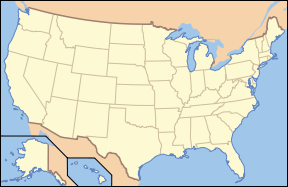
|
|
| Location: | California, USA |
| Nearest city: | Mariposa, California |
| Area: | 761,266 acres (3,081 km²) |
| Established: | October 1, 1890 |
| Visitation: | 3,280,911 (in 2004) |
| Governing body: | National Park Service |
Yosemite National Park (pronounced "Yo-SEM-it-ee"), is a U.S. national park largely in Mariposa and Tuolumne counties in the state of California. The park covers an area of 1,189 square miles (3,081 km²) and reaches across the western slopes of the Sierra Nevada mountain chain. Yosemite is visited by over 3.5 million visitors each year, with most only seeing the seven square miles of Yosemite Valley.
Designated a World Heritage Site in 1984, Yosemite is internationally recognized for its spectacular granite cliffs, waterfalls, clear streams, Giant Sequoia groves, and biological diversity. About 89 percent of the park is designated wilderness area. It was also the first park set aside by the U.S. federal government. Although not the first designated national park, Yosemite was a focal point in the development of the national park idea, largely owing to the work of people such as John Muir.
Yosemite is one of the largest and least fragmented habitat blocks in the Sierra Nevada, supporting a diversity of plants and animals. The park has an elevation range from 2,000 to 13,114 feet (600 to 4000 m) and contains five major vegetation zones: chaparral/oak woodland, lower montane, upper montane, subalpine and alpine. Of California's 7,000 plant species, about 50% occur in the Sierra Nevada and more than 20% within Yosemite.
John Muir, leading conservationist whose efforts were crucial to the founding of the National Park System and who founded the Sierra Club in 1892, described Yosemite thus:
"It is by far the grandest of all the special temples of Nature I was ever permitted to enter… Full of God's thoughts, a place of peace and safety amid the most exalted grandeur and eager enthusiastic action, a new song, a place of beginnings abounding in first lessons on life, mountain building, eternal, invincible, unbreakable order; with sermons in stones, storms, trees, flowers, and animals brimful with humanity." [1]

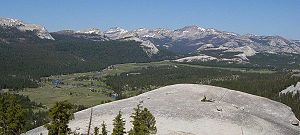
Geography
Yosemite National Park is located in the central Sierra Nevada of California. Yosemite is surrounded by wilderness areas: the Ansel Adams Wilderness to the southeast, the Hoover Wilderness to the northeast, and the Emigrant Wilderness to the north.
The 1,200-square-mile (3,100 km²) park contains thousands of lakes and pond]s, 1,600 miles (2,600 km) of streams, 800 miles (1300 km) of hiking trails, and 350 miles (560 km) of roads. Two federally designated Wild and Scenic Rivers, the Merced and the Tuolumne, begin within Yosemite's borders and flow westward through the Sierra foothills, into the Central Valley of California. Annual park visitation exceeds 3.5 million, with most visitor use concentrated in the seven square mile (18 km²) area of Yosemite Valley. [2]
Rocks and erosion
Almost all of the landforms in the Yosemite area are cut from the granitic rock of the Sierra Nevada Batholith (a large mass of intrusive igneous rock that formed deep below the surface). About five percent of the park, mostly in its eastern margin near Mount Dana, are from metamorphosed volcanic and sedimentary rocks. [3] These rocks are called "roof pendants" because they were once the roof of the underlying granitic rock.
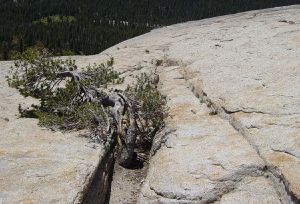
Erosion acting upon different types of uplift-created joint and fracture systems is responsible for creating the valleys, canyons, domes, and other features we see today (these joints and fracture systems do not move, and are therefore not geological faults). Spacing between joints and fracture systems is largely due to the amount of silica in the granite and granodiorite rocks; more silica tends to create larger spaces between joints and fractures and thus a more resistant rock.
Pillars and columns, such as Washington Column and Lost Arrow, are created by cross joints. Erosion acting on master joints is responsible for creating valleys and later canyons. The single most erosive force over the last few million years has been from large alpine glaciers, which have turned the previously V-shaped river-cut valleys into U-shaped glacial-cut canyons (such as Yosemite Valley and Hetch Hetchy Valley). Exfoliation (caused by the tendency of crystals in plutonic rocks to expand at the surface) acting on granitic rock with widely spaced joints is responsible for creating domes such as Half Dome and North Dome and inset arches like Royal Arches.
Popular features

Yosemite Valley represents only one percent of the park area, but this is where most visitors arrive and stay. El Capitan, a prominent granite cliff that looms over the valley, is one of the most popular world destinations for rock climbers because of its diverse range of difficulties and numerous established climbing routes in addition to its year-round accessibility. Impressive granite domes such as Sentinel Dome and Half Dome rise 3,000 feet and 4,800 feet (900 and 1450 m), respectively, above the valley floor.
The high country of Yosemite contains beautiful areas, such as Tuolumne Meadows, Dana Meadows, the Clark Range, the Cathedral Range, and the Kuna Crest. The Sierra crest and the Pacific Crest Trail run through Yosemite, with peaks of red metamorphic rock, such as Mount Dana and Mount Gibbs, and granite peaks, such as Mount Conness. Mount Lyell is the highest point in the park.
The park has three groves of ancient Giant Sequoia (Sequoiadendron giganteum) trees; the Mariposa Grove (200 trees), Tuolumne Grove (25 trees), and the Merced Grove (20 trees). Giant Sequoia are the most massive trees in the world and are one of the tallest and longest-lived. (Coast Redwoods that live along the Northern Californian coast are the tallest and the Great Basin Bristlecone Pine of Eastern California are the oldest). These trees were much more widespread before the start of the last Ice Age. [4]
Water and ice
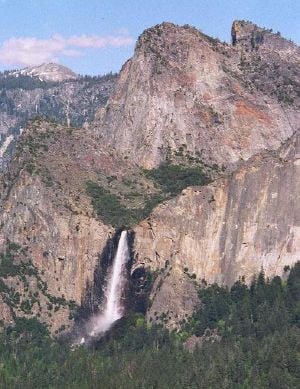
Tuolumne and Merced River systems originate along the crest of the Sierra Nevada in the park and have carved river canyons 3,000 to 4,000 feet (900 to 1200 m) deep. The Tuolumne River drains the entire northern portion of the park, an area of approximately 680 square miles (1760 km²). The Merced River begins in the park's southern peaks, primarily the Cathedral and Clark Ranges, and drains an area of approximately 511 square miles (1320 km²). [5]
Hydrologic processes, including glaciation, flooding, and fluvial geomorphic response, have been fundamental in creating landforms in the park. The park also contains approximately 3,200 lakes greater than 100 square meters, two reservoirs, and 1,700 miles (2700 km) of streams, all of which help form these two large watersheds. [6] Wetlands in Yosemite occur in valley bottoms throughout the park, and are often hydrologically linked to nearby lakes and rivers through seasonal flooding and groundwater movement. Meadow habitats, distributed at elevations from 3,000 to 11,000 feet (900 to 3500 m) in the park, are generally wetlands, as are the riparian habitats found on the banks of Yosemite's numerous streams and rivers. [7]
Yosemite is famous for its high concentration of waterfalls in a small area. Numerous sheer drops, glacial steps and hanging valleys in the park provide many places for waterfalls to exist, especially during April, May, and June, the snowmelt season. Located in Yosemite Valley, the 2425-foot-high (782 m) Yosemite Falls is the highest in North America and the third highest in the world. Also in the valley is the much lower volume Ribbon Falls, which has the highest single vertical drop, 1612 feet (492 m). Perhaps the most prominent of the Yosemite waterfalls is Bridalveil Fall, which is the waterfall seen from the Tunnel View viewpoint at the east end of the Wawona Tunnel. Wapama Falls in Hetch Hetchy Valley is another notable waterfall. Hundreds of ephemeral waterfalls also exist in the park.
All glaciers in the park are relatively small glaciers that occupy areas that are in almost permanent shade, such as north- and northeast-facing cirques. Lyell Glacier is the largest glacier in the Sierra Nevada (and therefore the park) and covers 160 acres (65 ha). None of the Yosemite glaciers is a remnant of the much, much larger Ice Age alpine glaciers responsible for sculpting the Yosemite landscape. Instead, they were formed during one of the neoglacial episodes that have occurred since the thawing of the Ice Age (such as the Little Ice Age). Global warming has reduced the number and size of glaciers around the world. Many Yosemite glaciers, including Merced Glacier, which was discovered by John Muir in 1871 and bolstered his glacial origins theory of the Yosemite area, have disappeared and most of the others have lost up to 75 percent of their surface area. [8]
Climate
The area of the park has a Mediterranean climate, meaning almost all yearly precipitation normally falls during a mild winter and the other seasons are nearly dry (less than 3% of precipitation falls in the typically long, hot summers). Due to orographic lift, precipitation increases with elevation until around 8000 feet (2400 m) when it slowly decreases to the crest. Precipitation amounts vary from 36 inches (915 mm) at 4,000 feet (1200 m) elevation to 50 inches (1200 mm) at 8,600 feet (2600 m). Snow does not typically persist on the ground until November in the high country. It accumulates all winter and into March or early April. [9]
Temperature decreases with increasing elevation. Temperature extremes are moderated by the fact that Yosemite is only about 100 miles (160 km) from the Pacific Ocean. An anticyclone sits off the coast of California in the summer, sending cool air masses toward the Sierra Nevada that result in clean dry air in the Yosemite area.
Mean daily temperatures range from 25 to 53 °F (-3.9 to 11.5 °C) at Tuolumne Meadows at 8,600 feet (2,600 m). At South Entrance near Wawona (elevation 6192 feet; 1887 m), mean daily temperature ranges from 36 to 67 °F (2.2 to 19.4 °C). At the lower elevations below 5,000 feet (1525 m), temperatures are hotter; the mean daily high temperature at Yosemite Valley (elevation 3,966 feet; 1209 m) varies from 46 to 90 °F (7.8 to 32.2 °C). At elevations above 8,000 feet (2440 m), the hot, dry summer temperatures are moderated by frequent summer thunderstorms, along with snow that can persist into July. The combination of dry vegetation, low relative humidity, and thunderstorms results in frequent lightning-caused fires as well.
History
The Ahwahneechee and the Mariposa Wars
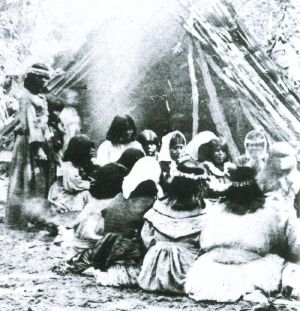
The known history of the Yosemite area started with Ahwahnechee and Paiute peoples who inhabited the central Sierra Nevada region of California that now includes Yosemite National Park. At the time when the first non-indigenous people entered the area, a band of Native Americans called the Ahwahnechee lived in Yosemite Valley. [10]
The California Gold Rush in the mid-nineteenth century dramatically increased white travel in the area. United States Army Major James Savage led the Mariposa Battalion into Yosemite Valley in 1851 while in pursuit of around 200 Ahwaneechees led by Chief Tenaya as part of the Mariposa Wars. Accounts from this battalion were the first confirmed cases of Caucasians entering the valley. Attached to Savage's unit was Dr. Lafayette Bunnell, the company physician, who later wrote about his awestruck impressions of the valley in The Discovery of the Yosemite. Bunnell is credited with naming the valley from his interviews with Chief Tenaya. Bunnell wrote that Chief Tenaya was the founder of the Pai-Ute Colony of Ah-wah-nee. The Miwoks (and most white settlers) considered the Ahwahneechee to be especially violent due to their frequent territorial disputes, and the Miwok word "yohhe'meti" literally means "they are killers." [11] Correspondence and articles written by members of the battalion helped to popularize the valley and surrounding area.
Tenaya and the rest of the Ahwahneechee were eventually captured and their village burned. They were removed to an Indian Reservation near Fresno, California. Some were later allowed to return to the valley, but got in trouble after attacking a group of eight gold miners in 1852. The band fled and took refuge with the nearby Mono tribe; but after reportedly stealing horses from their hosts, the Ahwahneechees were tracked down and killed by the Monos. A reconstructed "Indian Village of Ahwahnee" is now located behind the Yosemite Museum, which is next to the Yosemite Valley Visitor Center.
Early tourists
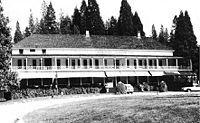
Entrepreneur James Mason Hutchings, artist Thomas Ayres, and two others ventured into the Yosemite area in 1855, becoming the valley's first tourists. Hutchings wrote articles and books about this journey and later excursions in the area and Ayres' sketches became the first accurate drawings of many prominent features. Photographer Charles Leander Weed took the first photographs of the Valley's features in 1859. Later photographers included Ansel Adams.
Wawona, California was an Indian encampment in what is now the southwestern area of the park. Settler Galen Clark discovered the Mariposa Grove of Giant Sequoia in Wawona in 1857. Simple lodgings were built, as were roads to the area. In 1879, the Wawona Hotel was built to serve tourists visiting the Grove. As tourism increased, so did the number of trails and hotels.
The Yosemite Grant
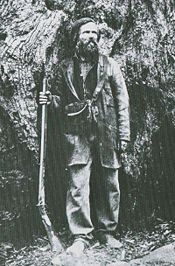
Concerned by the effects of commercial interests, several prominent people, including Galen Clark and Senator John Conness advocated for protection of the area. A park bill passed both houses of the U.S. Congress and was signed by President Abraham Lincoln on June 30, 1864, creating the Yosemite Grant. Yosemite Valley and the Mariposa Grove were ceded to California as a state park and a board of commissioners was proclaimed two years later. The Yosemite Grant counts as a landmark bill, as it predates the establishment of Yellowstone National Park, officially the first "national park."
Galen Clark was appointed by the commission as the grant's first guardian but neither Clark nor the commissioners had the authority to evict homesteaders (which included Hutchings). The issue was not settled until 1875 when the land holdings were invalidated. Clark and the reigning commissioners were ousted in 1880 and Hutchings became the new park guardian.
Access to the park by tourists improved in the early years of the park and conditions in the Valley were made more hospitable. Tourism started to significantly increase after the First Transcontinental Railroad was completed in 1869, but the long horseback ride needed to reach the area was a deterrent. Three stagecoach roads were built in the mid-1870s to provide better access to the growing number of visitors to the Valley.
Scottish-born naturalist John Muir first wrote many articles popularizing the area and increasing scientific interest in it. Muir was one of the first to theorize that the major landforms in Yosemite were created by large alpine glaciers, bucking established scientists such as Josiah Whitney, who regarded Muir as an amateur. Muir also wrote scientific papers on the area's biology.
Increased protection efforts
Overgrazing of meadows (especially by sheep), logging of Giant Sequoia, and other damage caused Muir to become an advocate for further protection. Muir convinced prominent guests of the importance of putting the area under federal protection. One such guest was Robert Underwood Johnson, editor of Century Magazine. Through Johnson, he was able to help pass an act of Congress that created Yosemite National Park on October 1, 1890. The State of California, however, retained control of the Valley and Grove. Muir also helped persuade local officials to virtually eliminate grazing from the Yosemite High Country.
The newly created national park came under the jurisdiction of the United States Army's Fourth Cavalry Regiment on May 19, 1891, which set up camp in Wawona. By the late 1890s, sheep grazing was no longer a problem, and the Army made many other improvements. The Cavalry could not intervene to help the worsening condition of the Valley or Grove.
Muir and his Sierra Club continued to lobby the government and influential people for the creation of a unified Yosemite National Park. In May 1903, President Theodore Roosevelt camped with John Muir near Glacier Point for three days. On that trip, Muir convinced Roosevelt to take control of the Valley and the Grove away from California and give it to the federal government. In 1906, Roosevelt signed a bill that did precisely that.
Later history
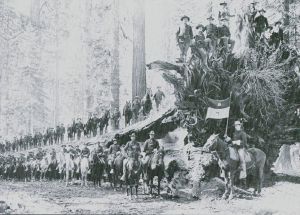
The National Park Service was formed in 1916 and Yosemite was transferred to that agency's jurisdiction. Tuolumne Meadows Lodge, Tioga Pass Road, and campgrounds at Tenaya and Merced lakes were also completed in 1916. Automobiles began to enter the park in ever-increasing numbers following the construction of all-weather highways to the park. The Yosemite Museum was founded in the early 1920s through the efforts of Ansel Franklin Hall.
To the north of Yosemite Valley but within the park is Hetch Hetchy Valley, which was slated for flooding to create a reservoir and hydroelectric power plant to benefit far-away San Francisco. A nationally polarized fight ensued, pitting preservationists like Muir and his Sierra Club against conservationists like Gifford Pinchot. The U.S. Congress eventually authorized the O'Shaughnessy Dam in 1913 through passage of the Raker Act.
Since then, preservationists have convinced Congress to designate 677,600 acres (2,742 km²), or about 89% of the park, as the Yosemite Wilderness—a highly protected wilderness area. The Park Service has also been moving away from allowing touristy inducements to visit the park, such as the famous Yosemite Firefall (in which red-hot embers were pushed off a cliff near Glacier Point at night). Increasing traffic congestion in Yosemite Valley during the summer months has also been an issue of concern. Proposals to exclude all automobiles in the summer that are not registered at a hotel or campground within the valley have been investigated. This would force all summer day-use visitors in the valley to use the free shuttle system, bike, or walk in the 7-mile-long (11 km) valley.
Geology
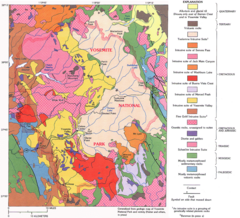
The exposed geology of the Yosemite area includes primarily granitic rocks with some older metamorphic rocks. The first rocks were laid down in Precambrian times, when the area around Yosemite National Park was on the edge of a very young North American continent. This area was astride a passive continental margin during the Precambrian and early Paleozoic eras.
Tectonic and volcanic activity
The sediment that formed the area first settled in the waters of a shallow sea, and compressive forces from a subduction zone in the mid-Paleozoic fused the seabed rocks and sediments, appending them to the continent.
Heat generated from the Farallon Plate subducting below the North American Plate led to the creation of an island arc of volcanoes on the west coast of proto-North America between the late Devonian and Permian periods (not unlike Japan) that were also thrust into the area of the park. In time, the igneous and sedimentary rocks of the area were later heavily metamorphosed.
The first phase of regional plutonism began 210 million years ago in the late Triassic and continued throughout the Jurassic to about 150 million years before present. Around the same time, the Nevadan orogeny built the Nevadan mountain range (also called the Ancestral Sierra Nevada) to a height of 15,000 feet (4500 m). This was directly part of the creation of the Sierra Nevada Batholith, and the resulting rocks were mostly granitic in composition and emplaced about 6 miles (10 km) below the surface. The second major pluton emplacement phase lasted from about 120 million to 80 million years ago during the Cretaceous. This was part of the Sevier orogeny.
Starting 20 million years ago (in the Cenozoic) and lasting until 5 million years ago a now-extinct extension of Cascade Range volcanoes erupted, bringing large amounts of igneous material in the area. These igneous deposits blanketed the region north of the Yosemite region. Volcanic activity persisted past 5 million years before present east of the current park borders in the Mono Lake and Long Valley Caldera areas.
Uplift and erosion
Starting 10 million years ago, vertical movement along the Sierra fault began to uplift the Sierra Nevada. Subsequent tilting of the Sierra block and the resulting accelerated uplift of the Sierra Nevada increased the gradient of western-flowing streams. The streams consequently ran faster and thus cut their valleys more quickly. Additional uplift occurred when major faults developed to the east, especially the creation of Owens Valley from Basin and Range-associated extensional forces. Uplift of the Sierra accelerated again about two million years ago during the Pleistocene.
The uplifting and increased erosion exposed granitic rocks in the area to surface pressures, resulting in exfoliation (responsible for the rounded shape of the many domes in the park) and mass wasting following the numerous fracture joint planes (cracks; especially vertical ones) in the now solidified plutons. Pleistocene glaciers further accelerated this process and the larger ones transported the resulting talus and till from valley floors.
Numerous vertical joint planes controlled where and how fast erosion took place. Most of these long, linear and very deep cracks trend northeast or northwest and form parallel, often regularly spaced sets. They were created by uplift-associated pressure release and by the unloading of overlying rock via erosion.
Sculpting by glaciers
A series of glaciations further modified the region beginning about 2 to 3 million years ago and ending sometime around 10,000 bp. At least 4 major glaciations have occurred in the Sierra Nevada; locally called the Sherwin (also called the pre-Tahoe), Tahoe, Tenaya, and Tioga. The Sherwin glaciers were the largest, filling Yosemite and other valleys, while later stages produced much smaller glaciers. A Sherwin-age glacier was almost surely responsible for the major excavation and shaping of Yosemite Valley and other canyons in the area.
Glacial systems reached depths of up to 4000 feet (1200 m) and left their marks in the Yosemite area. The longest glacier in the Yosemite area ran down the Grand Canyon of the Tuolumne River for 60 miles (95 km), passing well beyond Hetch Hetchy Valley. Merced Glacier flowed out of Yosemite Valley and into the Merced River Gorge. Lee Vining Glacier carved Lee Vining Canyon and emptied into Lake Russel (the much-enlarged ice age version of Mono Lake). Only the highest peaks, such as Mount Dana and Mount Conness, were not covered by glaciers. Retreating glaciers often left recessional moraines that impounded lakes such as Lake Yosemite (a shallow lake that periodically covered much of the floor of Yosemite Valley).
Biology
The plants of Yosemite National Park are diverse and complex and are a significant part of the exquisite beauty and biological diversity of the park. The combination of climate, topography, moisture, and soils influence the distribution of plant communities across an elevation gradient from 1,800 feet (549 m) to over 13,000 feet (3,900 m). Vegetation zones range from scrub and chaparral communities at lower elevations, to subalpine forests and alpine meadows at the higher elevations. There are 800 miles of trails in Yosemite, which provide access for exploring the five different vegetation zones. These zones are known officially as the Foothill Woodland Zone, Lower Montane Forest, Upper Montane Forest, Subalpine Forest, and Alpine Zones. [12]
Habitats
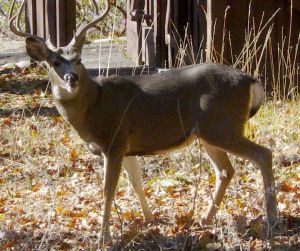
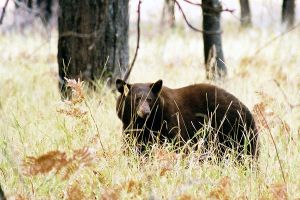
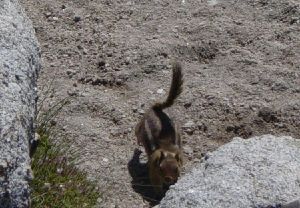
With habitats ranging from thick foothill chaparral to expanses of alpine rock, Yosemite National Park supports over 250 species of vertebrates, which include fish, amphibians, reptiles, birds, and mammals. This high diversity of species is also the result of habitats in Yosemite that are largely intact, compared to areas outside the park where various human activities have resulted in habitat degradation or destruction. [13]
Along much of Yosemite's western boundary, habitats are dominated by mixed coniferous forests of Ponderosa Pine, Sugar Pine, Incense-cedar, White Fir, and Douglas Fir, and a few stands of Giant Sequoia, interspersed by areas of Black Oak and Canyon Live Oak. A relatively high diversity of wildlife species are supported by these habitats, due to relatively mild, lower-elevation climate, and the mixture of habitat types and plant species. Wildlife species typically found in these habitats include Black Bear, Bobcat, Gray Fox, Mule deer, Mountain Kingsnake, Gilbert's Skink, White-headed Woodpecker, Brown Creeper, Spotted Owl, and a wide variety of bat species. In the case of bats, large snags are important as roost sites. [14]
Going higher in elevation, the coniferous forests become purer stands of Red Fir, Western White Pine, Jeffrey Pine, Lodgepole Pine, and the occasional Foxtail pine. Fewer wildlife species tend to be found in these habitats, due to their higher elevation, and lower complexity. Species likely to be found include Golden-mantled Ground Squirrel, Chickaree, Marten, Steller's Jay, Hermit Thrush, and Northern Goshawk. Reptiles are not common, but include Rubber Boa, western fence lizard, and Northern Alligator Lizard.
As the landscape rises, trees become smaller and more sparse, with stands broken by areas of exposed granite. These include Lodgepole Pine, Whitebark Pine, and Mountain Hemlock that, at highest elevations, give way to vast expanses of granite as treeline is reached. The climate in these habitats is harsh and the growing season is short, but species such as Pika, Yellow-bellied Marmot, White-tailed Jackrabbit, Clark's Nutcracker, and Rosy Finch are adapted to these conditions. Also, the treeless alpine habitats are the areas favored by Bighorn Sheep. This species, however, is now found in the Yosemite area only around Tioga Pass, where a small, reintroduced population exists. [15]
At a variety of elevations, meadows provide important, productive habitat for wildlife. Animals come to feed on the green grasses and use the flowing and standing water found in many meadows. Predators, in turn, are attracted to these areas. The interface between meadow and forest is also favored by many animal species because of the proximity of open areas for foraging and cover for protection. Species that are highly dependent upon meadow habitat include Great Gray Owl, Willow Flycatcher, Yosemite Toad, and Mountain Beaver. [16]
Management issues
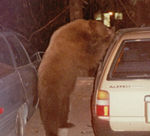
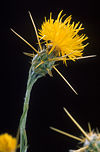
Despite the richness of high-quality habitats in Yosemite, three species have become extinct in the park within historical time, and another 37 species currently have special status under either California or federal endangered species legislation. The most serious current threats to Yosemite's wildlife and the ecosystems they occupy include loss of a natural fire regime, exotic species, air pollution, habitat fragmentation, and climate change. On a more local basis, factors such as road kills and the availability of human food have affected some wildlife species. The black bears of Yosemite were once famous for breaking into parked cars to steal food. They were also an encouraged tourist sight for many years at the park's garbage dumps, where bears congregated to eat park visitors' garbage and tourists gathered to photograph the bears. Increasing encounters between bears and humans and increasing damage to property led to an aggressive campaign to discourage bears from relying on human food or interacting with people and their property. Because those bears that show aggression towards people usually must eventually be destroyed, park personnel have continued to come up with innovative ways to have bears associate humans and their property with unpleasant experiences, such as being hit with rubber bullets. Today, about 30 bears a year are captured and ear-tagged and their DNA is sampled so that, when bear damage occurs, rangers can ascertain which bear is causing the problem. [17]
Increasing ozone pollution is causing tissue damage to the massive Giant Sequoia trees in the park. This makes them more vulnerable to insect infestation and disease. Since the cones of these trees require fire-touched soil to germinate, historic fire–suppression has reduced these trees' ability to reproduce. The current policy of setting prescribed fires will hopefully help the germination issue.
Yosemite National Park has documented more than 130 non-native plant species within park boundaries. These non-native plants were introduced into Yosemite following the migration of early Euro-American settlers in the late 1850s. Natural and human-caused disturbances, such as wildland fires and construction activities, have contributed to a rapid increase in the spread of non-native plants. A number of these species aggressively invade and displace the native plant communities, resulting in impacts on the park's resources. Non-native plants can bring about significant changes in park ecosystems by altering the native plant communities and the processes that support them. Some non-native species may cause an increase in the fire frequency of an area or increase the available nitrogen in the soil that may allow more non-native plants to become established. Many non-native species, such as Yellow Star Thistle, are able to produce a long tap root that allows them to out-compete the native plants for available water. [18]
Activities
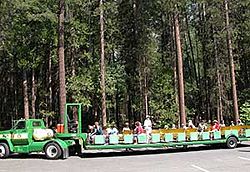
Yosemite Valley is open year-round, but much of the rest of the park is closed due to snow in late autumn and does not re-open until mid to late spring. Open-air tours around Yosemite Valley and the Mariposa Grove of Giant Sequoias are available. Many people enjoy short walks and longer hikes to waterfalls in Yosemite Valley, or walks amongst Giant Sequoias in the Mariposa, Tuolumne, or Merced Groves. Others like to drive or take a tour bus to Glacier Point in the summer and fall to see a spectacular view of Yosemite Valley and the high country, or drive along the scenic Tioga Road to Tuolumne Meadows, then go for a walk or hike. Almost all of the park, however, is highly-protected roadless wilderness that does not allow motorized vehicles and requires permits for overnight stays. Yosemite boast two National Historic Landmarks: the LeConte Memorial Lodge (Yosemite's first public visitor center); and the Ahwahnee Hotel.
Hiking: Over 800 miles (1300 km) of trails are available to hikers, from easy strolls, to grueling hikes up several park mountains, to multiple-day backpack trips. Most park workers strongly encourage guests to experience portions of the park other than Yosemite Valley. [19]
Driving destinations: While some locations in Yosemite require hiking, other locations can be observed via automobile transportation. Driving locations also allow guests to observe the night sky in locations other than their campsite or lodge. All of the roads in Yosemite are scenic, but the most famous is the Tioga Road, typically open from late May or early June through November. Bicycles are allowed on Yosemite's roads, though only 12 miles of paved trails exist for biking, excluding mountain biking, which is not allowed.

Climbing: Rock climbing is an important part of Yosemite. Camp 4—a walk-in campground in Yosemite Valley—was instrumental in the development of rock climbing as a sport, and is listed on the National Register of Historic Places. Climbers can generally be spotted in the snow-free months on anything from ten-foot-high (3 m) boulders to the 3,300-foot (1 km) face of El Capitan. Classes are offered by numerous groups on rock climbing. [20]
Winter activities: Many of the roads in the park close due to heavy snow in winter; however, Yosemite Valley is open all year long. Downhill skiing is available, as is cross-country skiing and snowshoeing, with several backcountry ski huts open for use. The Bracebridge dinner is an annual holiday event, held since 1927 at The Ahwahnee Hotel, inspired by Washington Irving's descriptions of Squire Bracebridge and English Christmas traditions of the 1700s in his Sketch Book. Between 1929 and 1973, the show was organized by Ansel Adams. [21]
Notes
- ↑ Famous John Muir Quotes National Park Service, Retrieved March 19, 2007
- ↑ Nature & Science, United States National Park Service: Yosemite National Park. Accessed March 9, 2007
- ↑ December 22, 2004, Geology: The Making of the Landscape, United States National Park Service: Yosemite National Park. January 27, 2007
- ↑ Eugene P. Kiver, and David V. Harris. Geology of U.S. Parklands: Fifth Edition. (New York, John Wiley & Sons, 1999, ISBN 0471332186), 227
- ↑ December 22, 2004, Water Overview, National Park Service: Yosemite National Park. Accessed March 9, 2007
- ↑ December 22, 2004, Hydrology and Watersheds, National Park Service: Yosemite National Park. Accessed March 9, 2007
- ↑ December 22, 2004, Wetland Vegetation , National Park Service: Yosemite National Park. Accessed March 9, 2007
- ↑ Eugene P. Kiver, and David V. Harris. Geology of U.S. Parklands: Fifth Edition. (New York, John Wiley & Sons, 1999, ISBN 0471332186), 228
- ↑ December 22, 2004, Climate, National Park Service: Yosemite National Park. Accessed March 9, 2007
- ↑ Lafayette H. Bunnell. 1892, Discovery of the Yosemite and the Indian War of 1880 Which Led to That Event, (Chicago: F.H. Revel. ISBN 0939666588) - Yosemite Online Library. Accessed March 7, 2007
- ↑ Daniel E. Anderson, July 2005, Origin of the Word Yosemite, The Yosemite Web. Accessed March 9, 2007
- ↑ Vegetation Overview, Yosemite National Park. Accessed March 10, 2007
- ↑ December 22, 2004 Wildlife Overview, National Park Service: Yosemite Park Service. Accessed March 10, 2007
- ↑ December 22, 2004 Wildlife Overview, National Park Service: Yosemite Park Service. Accessed March 10, 2007
- ↑ December 22, 2004 Wildlife Overview, National Park Service: Yosemite Park Service. Accessed March 10, 2007
- ↑ December 22, 2004 Wildlife Overview, National Park Service: Yosemite Park Service. Accessed March 10, 2007
- ↑ April 23, 2001, DNA to Help Identify "Problem" Bears at Yosemite, National Geographic. Accessed March 10, 2007
- ↑ December 22, 2004, Exotic Plants, National Park Service: Yosemite National Park. Accessed March 10, 2007
- ↑ October 13, 2006, Nature & History, United States National Park Service: Yosemite National Park. Accessed March 10, 2007
- ↑ February 27, 2003, Camp 4 Listed With National Register of Historic Places, National Park Service: Yosemite National Park. Accessed March 10, 2007
- ↑ December 26, 2006, Ansel Adams' love of Yosemite lives, The Cincinnati Enquirer. Accessed January 27, 2007
Sources and Further Reading
- Harris, Ann G., Geology of National Parks: Fifth Edition. Iowa, Kendall/Hunt Publishing, 1998, ISBN 0787253537
- Kiver, Eugene P., and David V. Harris. Geology of U.S. Parklands: Fifth Edition. New York, Jonh Wiley & Sons, 1999, ISBN 0471332186
- Schaffer, Jeffrey P., Yosemite National Park: a natural-history guide to Yosemite and its trails. Berkeley, CA: Wilderness Press, 1999, ISBN 0899972446 OCLC 41361419
- Wuerthner, George. Yosemite: A Visitor's Companion. Mechanicsburg, PA: Stackpole Books, 1994, ISBN 0811725987 OCLC 29314536
- United States; National Park Service; Division of Publications, Yosemite: a guide to Yosemite National Park, California. Washington, DC: U.S. Department of the Interior, 1990, ISBN 0912627379 - OCLC 18051523
External links
All links retrieved October 15, 2020.
- Yosemite, National Park Service
- The Yosemite Association, Yosemite Online
| National parks of the United States |
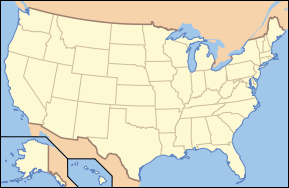
|
|---|---|
| Acadia • American Samoa • Arches • Badlands • Big Bend • Biscayne • Black Canyon of the Gunnison • Bryce Canyon • Canyonlands • Capitol Reef • Carlsbad Caverns • Channel Islands • Congaree • Crater Lake • Cuyahoga Valley • Death Valley • Denali • Dry Tortugas • Everglades • Gates of the Arctic • Glacier • Glacier Bay • Grand Canyon • Grand Teton • Great Basin • Great Sand Dunes • Great Smoky Mountains • Guadalupe Mountains • Haleakala • Hawaii Volcanoes • Hot Springs • Isle Royale • Joshua Tree • Katmai • Kenai Fjords • Kings Canyon • Kobuk Valley • Lake Clark • Lassen Volcanic • Mammoth Cave • Mesa Verde • Mount Rainier • North Cascades • Olympic • Petrified Forest • Redwood • Rocky Mountain • Saguaro • Sequoia • Shenandoah • Theodore Roosevelt • Virgin Islands • Voyageurs • Wind Cave • Wrangell-St. Elias • Yellowstone • Yosemite • Zion List by: date established, state |
Cahokia | Carlsbad Caverns | Chaco Culture | Everglades | Grand Canyon | Great Smoky Mountains | Hawaii Volcanoes | Independence Hall | Kluane / Wrangell-St. Elias / Glacier Bay / Tatshenshini-Alsek (w/ Canada) | La Fortaleza and San Juan National Historic Site, Puerto Rico | Mammoth Cave | Mesa Verde | Monticello and University of Virginia | Olympic | Pueblo de Taos | Redwood | Statue of Liberty | Waterton Glacier International Peace Park (w/ Canada) | Yellowstone | Yosemite
Credits
New World Encyclopedia writers and editors rewrote and completed the Wikipedia article in accordance with New World Encyclopedia standards. This article abides by terms of the Creative Commons CC-by-sa 3.0 License (CC-by-sa), which may be used and disseminated with proper attribution. Credit is due under the terms of this license that can reference both the New World Encyclopedia contributors and the selfless volunteer contributors of the Wikimedia Foundation. To cite this article click here for a list of acceptable citing formats.The history of earlier contributions by wikipedians is accessible to researchers here:
- Yosemite_National_Park history
- Geology_of_the_Yosemite_area history
The history of this article since it was imported to New World Encyclopedia:
- History of "Yosemite National Park"
Note: Some restrictions may apply to use of individual images which are separately licensed.
↧ Download as ZWI file | Last modified: 02/03/2023 23:13:52 | 15 views
☰ Source: https://www.newworldencyclopedia.org/entry/Yosemite_National_Park | License: CC BY-SA 3.0
 ZWI signed:
ZWI signed: KSF
KSF